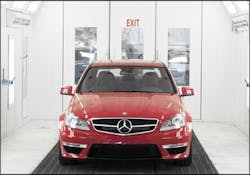Finishing in the Money: Proper Paint Booth Operation
By Brandon Lowder, Vice President of Auto Refinish, Global Finishing Solutions
There is no question that a paint booth is a large investment for many shops. The best way to protect that investment and to drive your profits is to ensure your booth is running in peak condition. By following proper prep work and painting processes, and paint booth maintenance tips, your booth will last longer while continuing to improve paint job quality and shop productivity.
Prepping for Success
Proper paint booth operation begins before you even enter the booth. The preparation you put into each job plays a critical role in achieving the highest quality results.
First, you should ask yourself if the part or vehicle is coming from storage. If so, pay attention to potential temperature differences between the storage area and the booth. Temperature differences between the part or vehicle and the coating can cause problems with adhesion or gloss and other surface defects.
Improving Your Spray Zone for Higher Quality Results
When masking, make sure you are not blocking the grated areas. Extend masking paper or plastic at most 6 inches below the vehicle and mask wheel wells and wheel covers only if they are within the area being sprayed. The remaining wheel wells should be open to create a consistent air path.
To keep contamination off the vehicle, you also want to make sure the booth’s air pressure is correctly balanced. A slightly positive pressure will ensure the cleanest paint job. That pressure causes a layer of slowmoving air—known as boundary air—to form on the vehicle surface. Boundary air shields contaminants from the painted surfaces.
If the booth has too much positive pressure, more air is being introduced to the cabin than can be removed. This causes contamination from the walls and floors to enter the spraying zone. Negative pressure, on the other hand, reduces the shield of clean air that is created and draws in contamination from door leaks or booth openings. If you need to make any pressure adjustments, do so when the vehicle is in the cabin and all of the doors are closed.
Maintaining Optimal Booth Performance
Often, a contaminated paint job is due to a dirty or poorly maintained booth. A few simple booth maintenance steps will help create a safe and efficient working environment for higher quality paint jobs. They will also extend the life of your paint booth.
It’s also important to keep dust out of your booth. When not in use, keep the paint booth doors closed. When you do need to open the booth doors to bring an object in, make sure the booth is on and running. Other tips include not leaving unnecessary items in the booth, limiting traffic in and out of the booth, never sanding in the booth and never spraying without a lint-free painter’s suit and head cover. Painting attire should be stored in a clean area.
The painting process often leads to overspray that needs to be carefully cleaned. Overspray can end up on walls, floors, paint guns and air hoses. If you don’t take proper care of it, paint can become airborne or flake off onto painted surfaces. Whatever method you choose for cleaning, make sure it is approved for use in hazardous locations like your booth. A great option for this is booth protection paper, which goes on the floor and walls. Once dirty, the paper can easily be removed and new paper laid down. It makes for easy and quick removal of overspray and is even available for covering light fixtures.
In the end, proper booth operation and maintenance is key to achieving the best finish possible for each vehicle while also increasing shop throughput and booth longevity. It begins before the vehicle even enters the booth and doesn’t end when the spray gun is put down. Emphasizing proper prep work, optimizing your spray zone in the booth and focusing on booth cleanliness and maintenance will build good habits which will elevate the quality of the work coming from your shop now and into the future.
